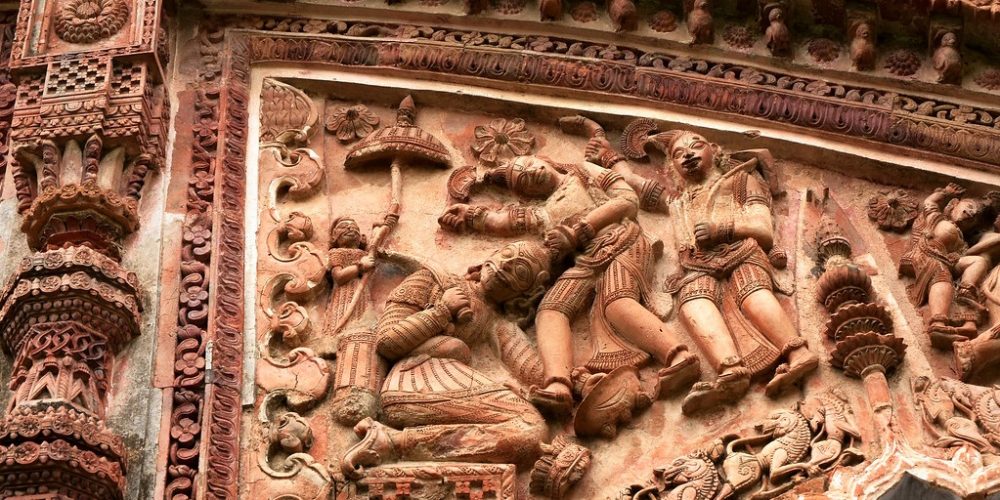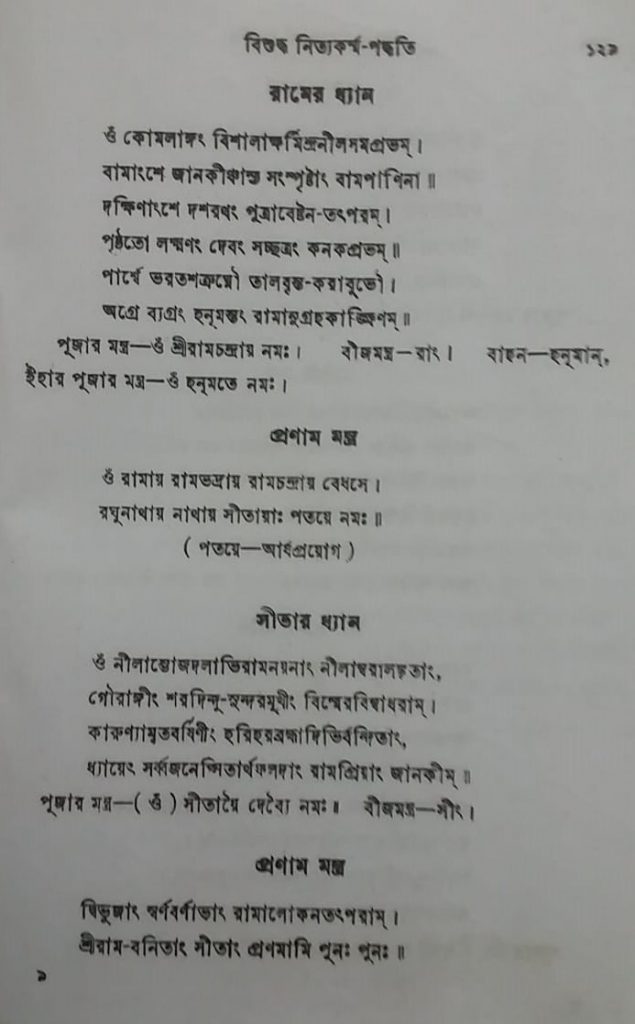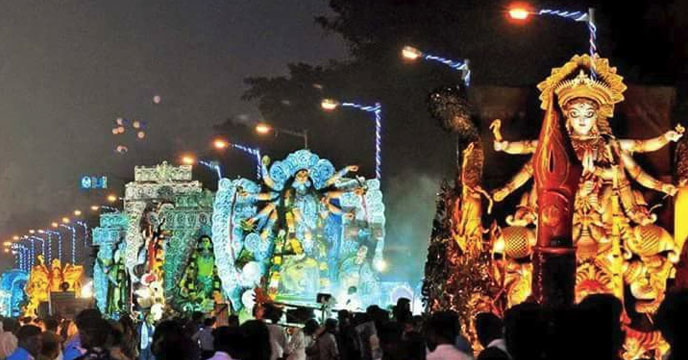A narrative which in recent times has gained popularity in media houses like ABP Ananda, Hindustan Times, and Bengali left-liberal “intellectual” circles is that of Rama versus Devi in the context of Bengali politics and identity. Bengali intellectuals and left-liberals wants us to believe that Rama is as alien cult and belongs to “them”, the “others” while Devi and her pantheon belongs exclusively to Bengalis. So noted humanitarian and self-professed agnostic film-maker Pritish Nandy[1] who has suddenly become a spokesperson of Hindu Bengalis writes:
“I sometimes wonder if these Jai Shri Ram walas have ever heard of goddess Saraswati. That is who we Bengalis worship. The goddess of learning, knowledge, wisdom. And we respect women. That is why we also worship Durga and Kali. Jai Shri Ram huh!”[2]
In an interview to Aaj Tak TV, West Bengal Chief Minister Mamata said she and her party believe in the slogan ‘Jai Hind’ and not ‘Jai Shri Ram’[3]. Writing for The Wire, Jawahar Sircar says that: “The Subaltern Deities of Bengal Are up Against Aggressive Hindutva Now.”[4] All this anti-Ram sentiment culminated in the arrest of three people in Ghatal, West Bengal in May 2019 for chanting ‘Jai Shri Ram’ while Chief Minister Mamata Banerjee’s convoy was passing by![5]
It is as if North Indians and BJP supporters alone worship and revere Rama and that Bengali Hindus worship only Durga, Kali and other female deities. This exclusivist posture and narrative being peddled by mainstream media and so-called intellectuals is completely ridiculous and baseless.
Rama Culture in Bengal
Snigdhendu Bhattacharya, writing for Hindustan Times claims that poet Michael Madhusudan Dutta’s Meghnad Badh kabya, which lionizes Ravana and criticizes Rama, represents the Bengali Hindu position on Rama. He writes: “Michael Madhusudan Dutta’s modern epic Meghnad Badh kabya (1861) – that hailed Ravana as a hero and looked down upon Rama – went on to become one of the most iconic literary creations of the Bengal Renaissance period. It speaks of a view that is diametrically opposite to that highlighted by the saffron camp.”[6]
Michael Madhusudan Dutta was indeed an important 19th-century Bengali poet and dramatist. Born to a Hindu family, from an early age he aspired to be an Englishman in both looks and manner, and to his family’s horror he converted to Christianity when he was young. He was an erudite scholar but his impact did not extend beyond intellectual circles. There is absolutely no evidence to indicate that his poems and dramas had any impact whatsoever on the Dharmic way of life of the common masses. In fact he was largely ignored for 15 years after his death in 1873[7].
On the other hand, the very fact that Michael Madhusudan Dutta decided to build upon a story from Ramayana and provide a different interpretation would indicate the popularity of Ramayana in Bengali psyche. Below I will present a few examples of how Rama culture exists deep in the hearts of Hindu Bengalis.
Historically, Bengal has had a very long tradition of Vaishnavism going back to the time of Adi Sankara or even earlier. As early as 9th century South Gangetic and Rahr Bengal (western Bengal) which was under the Malla kingdom had significant presence of Vaishnava culture. After this, Madhava’s school of Dvaita Vaishnavism gained primary prominence during 13th century and spread from Udupi to Bengal under the leadership of stalwarts like Madhavendra Puri, Ishvara Tirtha and Sri Chaitanya[8]. Chaitanya Mahaprabhu himself worshiped both Rama and Krishna.
It was in such an environment that Krttibas Ojha composed the Bengali version of Ramayana also known as Sri Ram Panchali in the 14th century. If Bengal did not have any Rama culture why would Bengalis even have a separate Ramayana? In fact Krttibas Ojha’s Ramayana, which contains vivid descriptions of the then Bengali social life and its values, inspired many later-day poets, including Michael Madhusudan Dutt and Rabindranath Tagore. Wakil Ahmed, a Bangladeshi Muslim writer says: “The religious, social and cultural traditions of the Hindu community are specially based on the story of Ramachandra. Bengali Hindus are therefore indebted to Krttivas for making this knowledge available to them through his Bangla translation of the Ramayana.”[9]
Hare Kṛṣṇa Hare Kṛṣṇa Kṛṣṇa Kṛṣṇa Hare Hare
Hare Rāma Hare Rāma Rāma Rāma Hare Hare
Even if a Bengali does not know any other mantra, this is one mantra almost every Bengali knows, irrespective of whether he be a village bumpkin or a Jadavpur University educated anti-statist post-modern atheist.
We have an old Bengali saying to stop children from getting scared, which I learnt from my grandfather: “Bhut amar put, petni amar jhi, Ram Lakkhan buke ache, korbi amar ki?” This means that if I have Ram and Lakshman in my heart, why should I get scared?
The very worship of Durga Puja today, Akal Bodhan is based on Ramayana. Akal Bodhan refers to the invocation of Durga during an uncustomary time (during Ashvina month) since the conventional period for worship was Basant.
“It was customary to worship Durga with 100 neel kamals (blue lotuses). Rama could gather only 99 of them; he offered one of his eyes as a substitute of the 100th lotus. Pleased with his devotion Durga blessed him. The battle started on Shaptami and Ravana was killed at the Shandhikshan (in between) Ashtami and Navami; he was cremated on Dashami. Therefore the four days of the puja that we celebrate ends in the triumph of the good over evil.”[10]
Pujas in Bengal region (and similar to rest of India) are conducted from texts known as Nityakarma Paddhati. These texts are based on Puranic as well as Tantra-Agama traditions. Krishnananda Agambagish’s (16th century) Brihat-tantrasara is perhaps the sourcebook of most Puja guides in Bengal region[11] and describes in details the Puja of Rama. So do the much latter voluminous Purohit Darpan texts. Even modern Nityakarma texts describe the dhyana and pranama mantra of Rama and Sita, along with others like Saraswati, Lakshmi, Sitala, Dakshinakali, Jagaddhatri, Ganga, Tulsi, Krishna, and Markandeya and so on.
Divide and Conquer
The narrative being peddled by the left-liberals is one of continuous tension between Bengalis who apparently worship only Devi and outsiders who worship only Rama. The left-liberals are very explicitly “othering” north Indians and pitting them against native Bengalis – ironically it is something which the left accuses the non-left of doing. Some social scientists have also labelled it as the schism between sub-altern and native deities of Bengal versus a hegemonic Hindutva and Hindi oriented Rama. Snigdhendu Bhattacharya building upon this narrative, portrays Bengal solely as the land of Durga Puja and Devis. He says:
“While Durga puja is the state’s biggest annual festival, and her daughters Laxmi and Saraswati are among the most popular household deities, temples dedicated to Radha-Krishna, Shiva and Kali dot West Bengal’s towns and villages. Among other deities popular in the state are goddesses Annapoorna, Jagaddhatri, Manasa, Sitala and Santoshi, while the popular Hindu festivals include Dol Jatra, Rath Jatra, Kali puja, Shivaratri, Saraswati Puja, Laxmi puja, Jagaddhatri puja and Jhulan.”[12]
There are a number of things which are wrong with this narrative. We must understand what is said explicitly and what is left unstated but implied by joining the dots. First of all it tries to imply that Bengal is distinct from other parts of India in that Hindu Bengalis are focused exclusively on Devi worship. It attempts to portray Bengal as distinct from Hindu mainstream because other regions apparently do not have this kind of Devi aradhana culture and are instead male-dominated patriarchal societies.
What Left Liberals forget, or intentionally ignore or simply don’t know, given the poor level of education in most humanities and social sciences departments today, is that there are at least 51 Shakti Peethas (or 108 as per traditional accounts) spread all across Indian subcontinent starting from Hinglaj Mata in Balochistan to Kamakhya in Assam, and Sharda Peeth in Kashmir to Kamakshi Amman Temple in Tamil Nadu. According to Brahmanda Purana, there are 64 Shakthi Peetha of Goddess Parvati in spread across present India, Bhutan, Bangladesh, Nepal, Sri Lanka, Tibet and Pakistan. In fact across entire India and especially in southern India, almost every village has its own village Goddess. Shakti worships is thus spread across entire Indian subcontinent and is not something unique to Bengal alone.
Far from being exclusively Devi-oriented, it is to be noted that every Bengali Hindu house is expected to perform Pancha Devata Puja (Ganesh, Surya, Shiva, Vishnu and Durga) along with Puja of their Ishta Devata which may be Durga, Kali, Shiva or any other deity. All Nitya Karma paddhati books detail the Puja norm. Bengal has a very rich and old Vaishnava tradition – both Gaudiya and other-wise. I myself come from a Vaishnava lineage and our kula-devata is Vishnu as Sridhar Narayana worshiped in Shalagrama shila form.
Does Durga Puja represent Bengali Hindu culture?
Does Durga Puja, in the form that we see today really represent the culture of Bengal? Let us briefly look at the history of Durga Puja.
According to traditional sources the earliest public worship of Durga Ma can be traced to late 16th century. Zamindars of Dinajpur and Malda, Raja Kangshanarayan of Taherpur and others started organizing Sharadiya or Autumn Durga Puja. Soon this specific kind of social event gained popularity and spread to Hooghly district and Guptipara became famous for its barowari Puja. Incidentally, Chandernagore adopted a variant known as Jagaddhatri Puja and is today famous for it. By 1800’s baro-wari Puja also became popular in Kolkata. It was only in early 20th century that sarbajanin or community puja (a small scale version of what we see today) became popular.
“The baro-yaari puja gave way to the sarbajanin or community puja in 1910, when the Sanatan Dharmotsahini Sabha organized the first truly community puja in Baghbazar in Kolkata with full public contribution, public control, and public participation. Now the dominant mode of Bengali Durga Puja is the ‘public’ version”[13]
In 1950s, Kolkata had only 300 Sarba-janin Puja celebrations. By 1995 this became 1120. Suddenly it reached 4000 in 2010[14], a phenomenal increase within a span of 2-3 decades.
What many people do not know is that paints giant Asian Paints had a huge role to play in the popularization of Durga Puja in the carnival format that we see it today. It all started with Asian Paints Sharad Shamman in 1985, an excellence award given to the best decorated Durga Puja Pandal in Kolkata. This kick-started a mad race for the best decorated and most expensive and outrageous pandals. Some of the popular Pandal names that we know today became popular during those early heady days.
- 1985 – Jodhpur Park, Adi Ballygunge, Maddox Square
- 1986 – College Square, Adi Ballygunge, Bagbazar Sarbojanin
- 1990 – Babubagan, Mudiali, Falguni Sangha
- And so on
Thus the highly commercialized Durga Puja that we see today is a very recent phenomena in the Dharmic history of Bengal, and has nothing to do with traditional Bengali Hindu culture. This unfettered commercialization started in 1980s when multi-national corporate entities converted Durga Puja to a consumer product which we continue to consume even today along with egg-roll, chicken biriyani, chowmein and pizza. Durga Puja today has less of Puja and more of mela, tamasha, fast food and western-style revelry.
Conclusion
Ajoy Chatterjee writes: “The practice of worshipping King Lord Ram in old Bengal was highly popular among Kshatriyas, royals and feudal lords; and districts of Medinipur and Nadia perhaps stand tall in terms of holding the most number of vintage Ram shrines in Bengal.”[15]
Krittibas Ojha’s Ramayana continues to be popular even today. Stories from Ramayana are found on terracotta temples. They have influenced Bengal’s folk art forms like the chhou dance of Purulia and scroll painter-singers of Midnapore and Burdwan[16].
Liberals claim that the fact that there are hardly any Ram temple in Bengal and the fact that people don’t worship Ram in “idol” form indicates that Ram was an outside cult with marginal impact of Bengali mainstream. Instead, what it actually shows is their ignorance of dharma and how people relate to dharma. It is to be noted that in general Ram temples are not common across entire India – there are far more Shiva, Devi, and Hanuman and Krishna temples as compared to exclusively Rama temples. Moreover all ancient temples in Bengal region have been systematically destroyed during the last 800 years and most of the temples that we see today were built in the last 2 centuries or so. So we can conclude nothing one way or the other because no old temple exists. Among recent temples, some of the most important Ram temples in the last 200-300 years are[17]:
- Ram Chandra Temple of Guptipara (Hooghly)
- Raghunath Mandir of Chandrakona (Medinipur)
- Ram Mandir and Ram Navami Fair of Ramrajatala (Howrah)
- Ramjiu Deul of Tamluk and Sita-Ram Mandir of Ghatal (Medinipur)
- Ramachandra Mandir of Chirulia (Medinipur)
- Raghunathji Mandir of Nashipur Akhara (Murshidabad)
- Sita Ramjiu Mandir of Rautara (Medinipur)
- Matiari Ram Sita Mandir and Rural Ram Navami Celebrations (Nadia)
- Garh Panchakot – Ruins of Ram Temple (Purulia)
- Ramchandra Mandir and Ram Navami of Narajole Royal Palace (Medinipur)
Thus it is not Devi versus Rama as main-stream media, TMC politicians, left-liberals and some Bengali intellectuals want us to believe. It is not an either/ or situation because we are not an exclusivist culture like Christians or Muslims who believe in only one God and notions like “kafir” and blasphemy. We have always worshiped all deities and shall continue to do so.
Rama was, is and shall continue to be in our hearts.
জয় শ্রী রাম !
Bibliography
Bhattacharya, S. (2017, April 6). Rama in Bengal: popular in tales, not so popular as deity, point out experts. Retrieved from Hindustan Times: https://www.hindustantimes.com/kolkata/rama-in-bengal-popular-in-tales-not-so-popular-as-deity-point-out-experts/story-sOq5zWawNuTTrRhkYzbImL.html
Chatterjee, A. (2019, April 16). Ram in Bengal. Retrieved from Voice of Nation Organiser: https://www.organiser.org/Encyc/2019/4/16/Ram-in-Bengal.html
Daily Asian Age. (2016, November 12). Michael Madhusudan Dutt. Retrieved from Daly Asian Age: https://dailyasianage.com/news/37396/michael-madhusudan-dutt
Gupta, P. (2014, February 27). My greatest asset is audacity: Pritish Nandy. Retrieved from Times of India: https://timesofindia.indiatimes.com/entertainment/hindi/bollywood/news/My-greatest-asset-is-audacity-Pritish-Nandy/articleshow/31041934.cms
India Today Web Desk. (2019, May 9). Mamata Banerjee exclusive: My slogan is Jai Hind and Vande Mataram not Jai Shri Ram. Retrieved from India Today: https://www.indiatoday.in/elections/lok-sabha-2019/story/mamata-banerjee-jai-hind-vande-mataram-jai-shri-ram-slogan-trinamool-west-bengal-1521202-2019-05-09
Sircar, J. (2017, April 21). The Subaltern Deities of Bengal Are up Against Aggressive Hindutva Now. Retrieved from The Wire: https://thewire.in/culture/bengal-deities-bjp-ram-durga
Notes
[1] (Gupta, 2014)
[2] https://twitter.com/PritishNandy/status/1126005407804055552
[3] (India Today Web Desk, 2019)
[4] (Sircar, 2017)
[5] In Mamata Banerjee’s West Bengal, three people detained for chanting ‘Jai Shri Ram’ https://www.timesnownews.com/elections/article/in-mamata-banerjees-west-bengal-three-people-detained-for-chanting-jai-shri-ram/412931
[6] (Bhattacharya, 2017)
[7] (Daily Asian Age, 2016)
[8] (Chatterjee, 2019)
[9] http://en.banglapedia.org/index.php?title=Krittivas_Ojha
[10] http://www.durga-puja.org/what-the-epics-say-akalbodhan.html
[11] http://www.brahminpedia.com/2016/04/krishnananada-agamavagisha.html
[12] (Bhattacharya, 2017)
[13] (Bhaduri 2004, 83) quoted in Nine Nights of the Goddess: The Navaratri Festival in South Asia edited by Caleb Simmons, Moumita Sen, Hillary Rodrigues
[14] Nights of the Goddess: The Navaratri Festival in South Asia edited by Caleb Simmons, Moumita Sen, Hillary Rodrigues Pg 125
[15] (Chatterjee, 2019)
[16] (Bhattacharya, 2017)
[17] (Chatterjee, 2019)
Featured Image: Flickr (From Ramayana : Char Bangla Temple, Murshidabad, West Bengal, India)
Disclaimer: The opinions expressed within this article are the personal opinions of the author. IndiaFacts does not assume any responsibility or liability for the accuracy, completeness, suitability, or validity of any information in this article.
Subhodeep Mukhopadhyay is from a data science background and his research interest includes history, religion and philosophy. He is the author of “The Complete Hindu’s Guide to Islam” and “Ashoka the Ungreat”.



